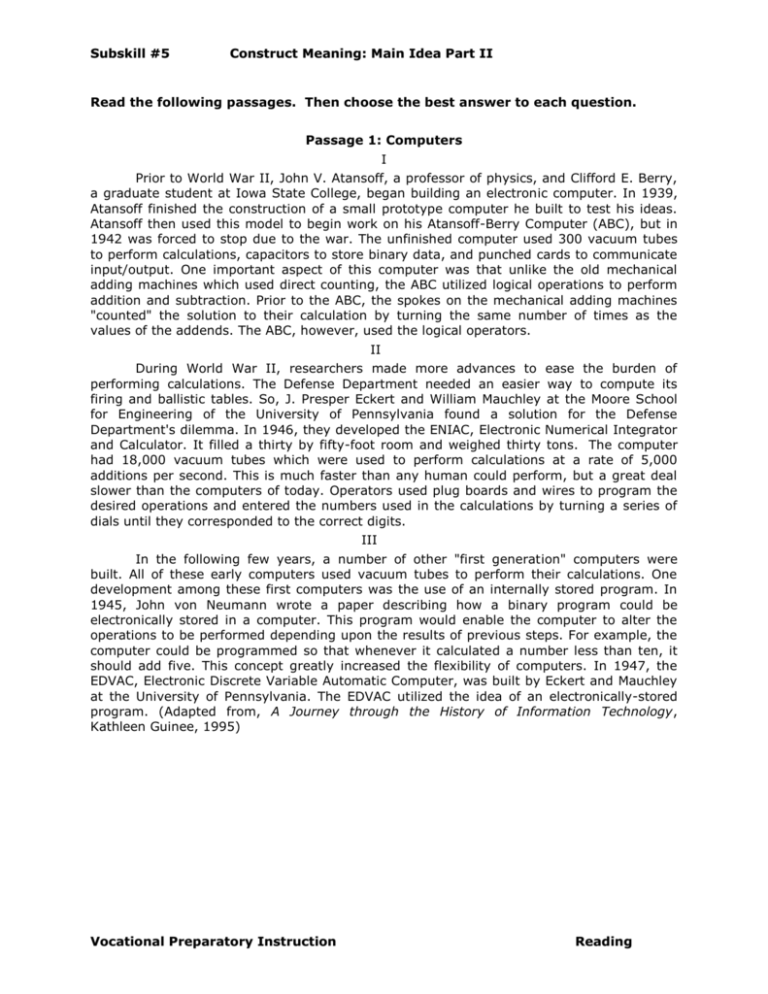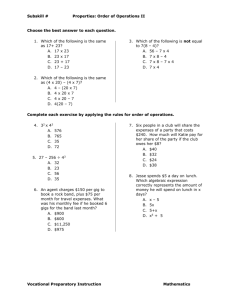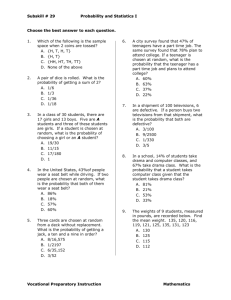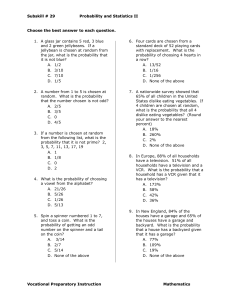
Subskill #5
Construct Meaning: Main Idea Part II
Read the following passages. Then choose the best answer to each question.
Passage 1: Computers
I
Prior to World War II, John V. Atansoff, a professor of physics, and Clifford E. Berry,
a graduate student at Iowa State College, began building an electronic computer. In 1939,
Atansoff finished the construction of a small prototype computer he built to test his ideas.
Atansoff then used this model to begin work on his Atansoff-Berry Computer (ABC), but in
1942 was forced to stop due to the war. The unfinished computer used 300 vacuum tubes
to perform calculations, capacitors to store binary data, and punched cards to communicate
input/output. One important aspect of this computer was that unlike the old mechanical
adding machines which used direct counting, the ABC utilized logical operations to perform
addition and subtraction. Prior to the ABC, the spokes on the mechanical adding machines
"counted" the solution to their calculation by turning the same number of times as the
values of the addends. The ABC, however, used the logical operators.
II
During World War II, researchers made more advances to ease the burden of
performing calculations. The Defense Department needed an easier way to compute its
firing and ballistic tables. So, J. Presper Eckert and William Mauchley at the Moore School
for Engineering of the University of Pennsylvania found a solution for the Defense
Department's dilemma. In 1946, they developed the ENIAC, Electronic Numerical Integrator
and Calculator. It filled a thirty by fifty-foot room and weighed thirty tons. The computer
had 18,000 vacuum tubes which were used to perform calculations at a rate of 5,000
additions per second. This is much faster than any human could perform, but a great deal
slower than the computers of today. Operators used plug boards and wires to program the
desired operations and entered the numbers used in the calculations by turning a series of
dials until they corresponded to the correct digits.
III
In the following few years, a number of other "first generation" computers were
built. All of these early computers used vacuum tubes to perform their calculations. One
development among these first computers was the use of an internally stored program. In
1945, John von Neumann wrote a paper describing how a binary program could be
electronically stored in a computer. This program would enable the computer to alter the
operations to be performed depending upon the results of previous steps. For example, the
computer could be programmed so that whenever it calculated a number less than ten, it
should add five. This concept greatly increased the flexibility of computers. In 1947, the
EDVAC, Electronic Discrete Variable Automatic Computer, was built by Eckert and Mauchley
at the University of Pennsylvania. The EDVAC utilized the idea of an electronically-stored
program. (Adapted from, A Journey through the History of Information Technology,
Kathleen Guinee, 1995)
Vocational Preparatory Instruction
Reading
Subskill #5
Construct Meaning: Main Idea Part II
Now choose the best answer to each question.
1. Identify the Main Idea of Paragraph I:
2. Identify the Main Idea of Paragraph II:
A. Atansoff and Berry were forced to
suspend their work due to the
outbreak of war.
A. ENIAC was developed to help the
defense department perform
necessary calculations.
B. The new computer used many
tubes to help with calculations.
B. ENIAC performed 5000 operations
per second.
C. The spokes are what is used to
perform calculations.
C. ENIAC weighed 30 tons.
D. ENIAC was programmed with a
series of plugs and wires.
D. The new computer was able to use
logical operation for adding and
subtracting; it did not rely on
mechanical counting.
3. Identify the Main Idea of Paragraph III:
A. Many other computer
developments followed ENIAC.
B. A very important development in
early computers was the
electronically stored program
C. The EDVAC was built by Eckert and
Mauchley at the University of
Pennsylvania in 1947.
D. All early computers used vacuum
tubes.
Passage 2: Construction of the Pyramids
I
The shape of the pyramids is the logical one for producing buildings of great height
when the building material available is stone. The design mimics the natural geometry of a
mountain, an incline of about 52 degrees. The Egyptian architects realized the ever
widening base would easily support the increasing number of stone blocks above it, making
the structure very stable. The shape demanded large blocks. An average 2 ½ ton limestone
block used in the pyramid construction would have probably taken eight men nine or ten
days to move from the quarry, float across the Nile, and drag to the top of the pyramid.
II
The most likely method of getting the blocks to the top of the structure was through
massive construction ramps. Exactly how the ramps were laid out is unknown, but they may
have been straight or in a spiral pattern around the pyramid. The ramps may have been
topped with a surface of tafla, a clay. Tafla, when wet, becomes very slippery and may have
allowed the Egyptian builders to use shorter, steeper ramps than might have otherwise
been possible. By wetting the ground in front of the block a slick path would be created
Vocational Preparatory Instruction
Reading
Subskill #5
Construct Meaning: Main Idea Part II
allowing the stone to be dragged by rope as it sat on sledges. It is also possible the stones
could have been moved on rollers. By placing rounded logs under the stone, crude wheels
would have made the load easier to pull. Pictures inscribed on ancient monument walls,
though, suggest the blocks were dragged without the aid of rollers. Once a stone was at the
top of the pyramid, it was probably moved into its final position with the use of levers.
(Copyright Lee Krystek 1997. All Rights Reserved.)
Now choose the best answer to each question.
4. Identify the Main Idea of Paragraph I:
5. Identify the Main Idea of Paragraph II:
A. The average block in the pyramids
weighs 2 ½ tons.
A. Ramps and slippery clay were most
likely used to move the heavy
blocks into
B. The design of a pyramid mimics
that of a mountain
place.
C. The pyramids shape is logical for
building structures of great height.
B. Rounded logs were most likely
used to move the heavy blocks into
place.
D. The huge stone blocks were floated
across the Nile River.
C. Levers were used once a block was
at the top of the pyramid.
D. Egyptian builders were adept at
building great structures.
Passage 3: EMS
I
J.D. "Deke" Farrington, MD, FACS is known as the father of modern EMS.
Farrington, and others, questioned why the lessons learned by the military medical corps
during World War II and the Korean War could not be brought into the civilian community to
improve the standard of civilian care. During the 1950s, emergency medicine and EMS
were not as advanced as what we enjoy today.
II
In San Francisco, New York, New Orleans, and other American cities, interns were
assigned to ambulances to provide care for the victims of trauma and other conditions
outside of the hospital. Most hospitals did not have a place to manage emergencies. Some
hospitals had set up an unstaffed "emergency room" at the back of the hospital. The
"ambulance driver" had to ring the doorbell beside the emergency room door so that the
nurse could come down from the ward to unlock the door. The nurse then checked the
patient and called a physician from home if she thought that the patient was really sick.
(Did you ever wonder why modern emergency departments are in the rear of the hospital
and not out front? Tradition.) All the physicians on staff had to take turns "covering the
emergency room." A patient involved in a major wreck with multiple fractures, and perhaps
a ruptured spleen or a head injury, might be seen by an ophthalmologist or a dermatologist.
Many physicians knew that they were ill prepared to handle trauma or a major myocardial
infarction, but there was no alternative. (Taken from History of EMS by Norman E. McSwain,
Jr).
Vocational Preparatory Instruction
Reading
Subskill #5
Construct Meaning: Main Idea Part II
Now choose the best answer to each question.
6. Identify the Main Idea of Paragraph I:
A. J.D. "Deke" Farrington is the
founder of modern emergency
medical services.
B. Modern emergency medical services
come from lessons learned during
the Korean War.
7. Identify the Main Idea of Paragraph II:
A. San Francisco and New Orleans had
very poor emergency response.
B. Emergency rooms are located to
the rear of most hospitals due to
tradition.
C. Emergency services and EMS have
changed greatly since the 1950s.
C. In the 1950s, Physicians took turns
staffing the emergency room even
if they were not qualified to do so.
D. Emergency services and EMS have
remained the same since the
1950s.
D. Hospitals had a lack of what we
would call high quality emergency
care prior to modern EMS.
Passage 4: Welding
Welding is a process by which two or more pieces of metal are joined together
through the application of heat, pressure, or a combination of both. Most welding processes
may be grouped into two main categories: pressure welding, in which the weld is achieved
by pressure; and heat welding, in which the weld is achieved by heat. Heat welding is the
most common welding process used today. With the development of new techniques during
the first half of the 20th century, welding replaced bolting and riveting in the construction of
many types of structures, including bridges, buildings, and ships. It is also a basic process
in the automotive and aircraft industries and in the manufacture of machinery. Along with
soldering and brazing, it is essential in the production of virtually every manufactured
product that involves metals. The welding process best suited to joining two pieces of metal
depends on the physical properties of the metals, the specific use to which they are applied,
and the production facilities available. Welding processes are generally classified according
to the sources of heat and pressure used. (Taken from Encarta Encyclopedia)
Choose the best answer for question 8.
8. Identify the Main Idea of Passage 4:
A. Welding is a method of soldering
and brazing.
B. Welding is used in heavy
manufacturing.
C. Welding is a process of joining
metals.
D. Welding is essential in the
automotive and aircraft industries.
Vocational Preparatory Instruction
Reading
Subskill #5
Construct Meaning: Main Idea Part II
Passage 5: Dental Assisting
Blood oozing from an open tooth socket after extraction can be controlled by the
application of a folded sterile gauze sponge compress over the wound. The patient is
requested to bite firmly, and the compress may remain in place for 20 to 30 minutes. It is
replaced as necessary with a fresh compress until bleeding is controlled. If the wound
cannot be controlled with the application of a compress, the operator/dentist may suture the
wound closed. Another alternative is to cauterize the area with the electric cautery. If a
severed blood vessel is the cause of the hemorrhage, the dentist may ligate the vessel. (As
used here ligate means to tie closed.) If the injury to the tissue is more complex, the dentist
may request that a physician be called to attend to the patient. (Taken from Modern Dental
Assisting)
Now choose the best answer for question 9.
9. Identify the Main Idea of Passage 5:
A. Bleeding can occur after a tooth
extraction.
B. Excessive bleeding after tooth
extraction can be controlled in
several different ways.
C. Some bleeding after a tooth
extraction is so severe that a
physician may have to be called to
treat the patient.
D. Bleeding after tooth extraction is
usually controlled through the use
of a folded sterile gauze sponge.
Passage 6: Electronics Safety
TVs and computer or video monitors are among the more dangerous of consumer
electronic equipment when it comes to servicing. (Microwave ovens are probably the most
hazardous due to high voltage at high power.) There are two areas which have particularly
nasty electrical dangers: the non-isolated line power supply and the CRT high voltage. Major
parts of nearly all modern TVs and many computer monitors are directly connected to the
AC line - there is no power transformer to provide the essential barrier for safety and to
minimize the risk of equipment damage. In the majority of designs, the live parts of the TV
or monitor are limited to the AC input and line filter, degauss circuit, bridge rectifier and
main filter capacitor(s), low voltage (B+) regulator (if any), horizontal output transistor and
primary side of the flyback (LOPT) transformer, and parts of the startup circuit and standby
power supply. The flyback generates most of the other voltages used in the unit and
provides an isolation barrier so that the signal circuits are not line connected and safer.
(Taken from Notes on the Troubleshooting and Repair of Television Sets Version 3.09
Copyright © 1994-2004 Samuel M. Goldwasser , All Rights Reserved)
Vocational Preparatory Instruction
Reading
Subskill #5
Construct Meaning: Main Idea Part II
Now choose the best answer for question 10.
10. Identify the Main Idea of Passage 6:
A. Care must be taken when servicing
Television, computer and video
monitors because of potential
electrical dangers.
B. Microwave oven are the most
dangerous household appliance to
repair.
C. Major parts of television are
connected to the AC power line.
D. The isolation barrier provides
safety and security for anyone
attempting to repair a television or
the monitor.
Vocational Preparatory Instruction
Reading
Subskill #5
Construct Meaning: Main Idea Part II
Answer Key
1.
D
2.
A
3.
B
4.
C
5.
A
6.
A
7.
D
8.
C
9.
B
10.
A
Vocational Preparatory Instruction
Reading








